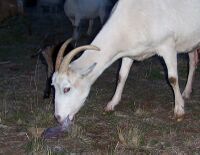Social:Placentophagy
Placentophagy (from 'placenta' + Greek φαγειν, to eat; also referred to as placentophagia) is the act of mammals eating the placenta of their young after childbirth.
The placenta contains small amounts of oxytocin which eases birth stress and causes the smooth muscles around the mammary cells to contract and eject milk. </ref>
There is also a school of thought that holds that placentophagy naturally occurred to hide any trace of childbirth from predators in the wild. Many placental mammals participate in placentophagy, including herbivores; exceptions include mainly humans, Pinnipedia, Cetacea, and camels. Placentophagy has been observed in Insectivora, Rodentia, Chiroptera, Lagomorpha, Carnivora, Perissodactyla, Artiodactyla (with the camel as a noted exception), and Primates. Marsupials, which are an order of metatherian (pouched) mammals, resorb rather than deliver the placenta, and therefore cannot engage in placentophagia; they do, however, vigorously lick birth fluids as they are excreted.[1]
Some research has shown that ingestion of the placenta can increase the pain threshold in pregnant rats. Rats that consumed the placenta experienced a modest amount of elevation of naturally occurring opioid-mediated analgesia. Endogenous opioids, such as endorphin and dynorphin, are natural chemicals, related to the opium molecule, that are produced in the central nervous system. Production of these endogenous opioids is increased during the birthing process. They have the ability to raise the threshold of pain tolerance in the mother. When coupled with ingested placenta or amniotic fluid, the opioid effect on pain threshold is dramatically increased. Rats that were given meat instead of the placenta showed no increase in the pain threshold. There are no studies that show any benefits of placenta ingestions in humans. There have been no scientific studies which show that placentophagy enhances analgesia in humans or that it has any other benefits.[2][3]
Human placentophagy
Although the placenta is revered in many cultures, there is scarce evidence that any customarily eat the placenta after the newborn's birth.[4] The medical use of eating a small section of the placenta accompanied by some honey to successfully control post-partum hemorrhage, however, has been accounted for in midwifery practices, and has worked even after typical administration of herbs or pitocin only temporarily stopped bleeding.[5]
Those who advocate placentophagy in humans believe that eating the placenta prevents postpartum depression and other pregnancy complications.[6][unreliable medical source?] Obstetrician and spokesperson for the Royal College of Obstetricians and Gynaecologists Maggie Blott disputes the post-natal depression theory, stating there is no medical reason to eat the placenta: "Animals eat their placenta to get nutrition - but when people are already well-nourished, there is no benefit, there is no reason to do it."[7] While no scientific study has proven any benefits, a survey was conducted by American Medical anthropologists at the University of South Florida and University of Nevada, Las Vegas. Among the respondents, about 3/4 claimed to have positive experiences from eating their own placenta, citing "improved mood", "increased energy", and "improved lactation".[8] [9]
Human placenta has also been an ingredient in some traditional Chinese medicines,[10] including using dried human placenta, known as "Ziheche" (simplified Chinese: 紫河车; traditional Chinese: 紫河車; pinyin: Zǐhéchē), to treat wasting diseases, infertility, impotence and other conditions.[11] Most recently, the CDC[12] published a report of a newborn infected with Group B Streptococcus (GBS) bacteria likely after the mother ingested placenta capsules. Consequently, the CDC said that placenta capsule ingestion should be avoided and to educate mothers interested in placenta encapsulation about the potential risks. A recent publication [13] advised that physicians should discourage placentophagy because it is potentially harmful with no documented benefit.
British celebrity chef Hugh Fearnly-Whittingstall, known for his series of River Cottage programmes, notoriously cooked and ate a woman's placenta on one of his programmes.[14]
See also
- Self-Cannibalism
References
- ↑ Mark B. Kristal (2 February 1980), "Placentophagia: A Biobehavioral Enigma", Neuroscience & Biobehavioral Reviews 4: 141–150, doi:10.1016/0149-7634(80)90012-3, archived from the original on October 13, 2006, https://web.archive.org/web/20061013004927/http://cogprints.org/757/00/gustibus.htm, retrieved 2007-12-12
- ↑ Mark B. Kristal (May 2012), "Placentophagia in Humans and Nonhuman Mammals: Causes and Consequences", Ecology of Food and Nutrition, http://www.acsu.buffalo.edu/~kristal/placentophagia%20review.pdf
- ↑ Mark B. Kristal (1991), "Enhancement of Opioid-Mediated Analgesia: A Solution to the Enigma of Placentophagia", Neuroscience and Biobehavioral Reviews, http://cogprints.org/180/1/review.html
- ↑ "In Search of Human Placentophagy: A Cross-Cultural Survey of Human Placenta Consumption, Disposal Practices, and Cultural Beliefs". Ecol Food Nutr. 2010 Nov-Dec;49(6):467-84.. http://www.lucina.ca/plresearch/In%20search%20of%20human%20placentophagy%202010.pdf. Retrieved 20 June 2012. Abstract at NIH website, accessed 20 June 2012
- ↑ Lim, Robin (2015). Placenta - The Forgotten Chakra (Rev. ed.). Bali, Indonesia: Half Angel Press. pp. 122, 128. ISBN 0-9762907-7-4.
- ↑ "Deal in the womb: fetal opiates, parent-offspring conflict, and the future of midwifery", Medical Hypotheses 67 (5): 1189–1194, 2006, doi:10.1016/j.mehy.2006.03.053, PMID 16893611, http://www.zoologia.hu/list/apari_rozsa.pdf
- ↑ Why eat a placenta?, BBC News, 2006-04-18, http://news.bbc.co.uk/1/hi/magazine/4918290.stm, retrieved 2007-12-12
- ↑ Bawany, Afsha (February 27, 2013). "Steamed, Dehydrated or Raw: Placentas May Help Moms’ Post-Partum Health. UNLV anthropology survey examines why women consume their placentas after childbirth.". UNLV News Center. http://news.unlv.edu/article/steamed-dehydrated-or-raw-placentas-may-help-moms%E2%80%99-post-partum-health. Retrieved March 25, 2013.
- ↑ "Human Maternal Placentophagy: A Survey of Self-Reported Motivations and Experiences Associated with Placenta Consumption". Ecology of Food and Nutrition. Archived from the original on February 16, 2015. https://web.archive.org/web/20150216214212/http://news.unlv.edu/sites/default/files/EFN%20Placentophagy%20Survey%20%28Selander,%20Cantor,%20Young%20and%20Benyshek%202013%29.pdf. Retrieved March 25, 2013.
- ↑ "Traditional Chinese medicine contains human placenta". News-Medical.Net. May 8, 2004. http://www.news-medical.net/print_article.asp?id=1333. Retrieved 2007-12-12.
- ↑ Tierra, Lesley; Tierra, Michael (1998), Chinese traditional herbal medicine, Twin Lakes, WI: Lotus Light Pub, pp. 225, ISBN 0-914955-32-2
- ↑ "Error: no
|title=specified when using {{Cite web}}". Centers for Diseases Control (CDC). https://www.cdc.gov/mmwr/volumes/66/wr/mm6625a4.htm. - ↑ [1] American Journal of Obstetrics and Gynecology
- ↑ "Channel 4 rapped for serving placenta". BBC. http://news.bbc.co.uk/1/hi/entertainment/101944.stm. Retrieved 17 December 2012.



